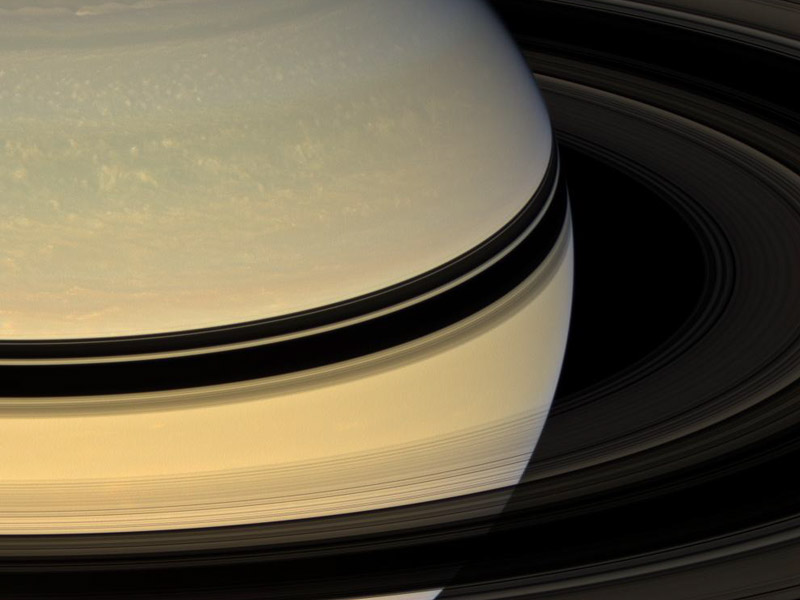
Saturn's Rings from the Other Side
Credit: Cassini Imaging Team, SSI, JPL, ESA, NASA
Posted on 06/09/2008 1:29:47 PM PDT by sig226

Explanation: What do Saturn's rings look like from the other side? From Earth, we usually see Saturn's rings from the same side of the ring plane that the Sun illuminates them. Geometrically, in the above picture taken in April by the robot Cassini spacecraft now orbiting Saturn, the Sun is behind the camera but on the other side of the ring plane. This vantage point, specifically 17 degrees above the ring plane, gives a breathtaking views of the most splendid ring system in the Solar System. Strangely, the rings have similarities to a photographic negative of a front view. The ring brightness as recorded from different angles indicates ring thickness and particle density of ring particles. Elsewhere, ring shadows can be seen on the sunlit face of Saturn, shown sporting numerous cloud structures in nearly true color.

d
Saturn is my fav planet...pluto is underated : (
That’s incredible
Wow!
These are all “terms of art”, and hence not to be altered. That is, Saturn has a “ring system” not just “rings”, so you don’t edit it down to avoid repetition. Similarly, “particle density” is in contradistinction to mass density, for example, and is a property of the “ring particles” and not some other particles. I myself would have no objection to “particle density of the rings”, but I understand this kind of talk.
I wonder what the rings would look like if one were on the planet looking up.
The Wikipedia article on Rings of Saturn has a similar Cassini photo from May 9, 2007, but with no silhouetting. However, if you click on it and click again for "full resolution" you get a really giant view which shows the fine structure of the rings. Sliding the horizontal bar gives me a dizzy feeling!

Hey that's a good question! Of course, you couldn't really be "on the planet" since Saturn does not have a distinct surface. If you were low enough to be supported by buoyancy, I feel sure you wouldn't be able to see the sky at all, so I suppose we have to content ourselves with "low Saturn orbit", which would provide the geometrically equivalent view.
From the equator, the rings would be a very thin line from horizon to horizon, passing straight overhead. They would be invisible in daylight, and at night would be partially eclipsed by Saturn ... Say, this is getting complicated!
For a midlatitude view, we can imagine making a simple model by drawing chalk rings on a pavement and standing offset from the center. Say our eyes are 5' off the ground, then standing about 5' from the center would simulate a midlatitude "surface view". The thin D and C rings would begin almost at your feet with a radius of just 9', right at the horizon from a midlatitude perspective. The bright B ring would have a radius of just 11', so it would arc very low in the sky. The Cassini division would be at 14' and the F ring at 16' would mark the outer edge of the bright rings. So all the rings would be within about 20 degrees of the horizon. It seems that getting the rings high in the sky "from the surface" would require you to be near the equator with a fairly "edge on" view. Very interesting considerations ( to me, anyway ) but I guess they hardly hint at the subjective impression such a view might make.
Yep, and you can see right away that the geometry is all wrong. You would have to be at least several Saturn diameters away from the center of Saturn to get this sort of perspective on the rings.
In fact, the illustration misrepresents the proportions of the rings altogether. They're much wider than that in comparison to their outer radius. They inner D and C rings are depicted, but they would be invisible in the bright sky that is shown. In fact they are all but invisible telescopically. I guess if you expanded the brighter A and B rings to the total width shown it wouldn't be too far off, but it is still nothing like a Saturn surface view, geometrically.
At the time, I must have went through a thousand google images and only found that one. I’d like to find a better one myself, there just doesn’t seem to be any.
... in fact, the subject "Picture of the day" gives a nice close-up view as well.
Funny thing, when Cassini was in route to Saturn, I was all excited because I assumed, for some reason, that it would get real "in close" with the rings, so that we would get images of the ring particles, or moonlets, themselves ... like this no doubt fanciful depiction:

But, alas and alack, it was not to be! The realities of Saturn's deep gravitational well preclude any such manouever.

The rings cast such a dark distinct shadow- if you were in this shadow, would the rings appear dark? Would it seem like night time?
To me, viewing the planet in a telescope is the most awesome sight in the universe.
Disclaimer: Opinions posted on Free Republic are those of the individual posters and do not necessarily represent the opinion of Free Republic or its management. All materials posted herein are protected by copyright law and the exemption for fair use of copyrighted works.